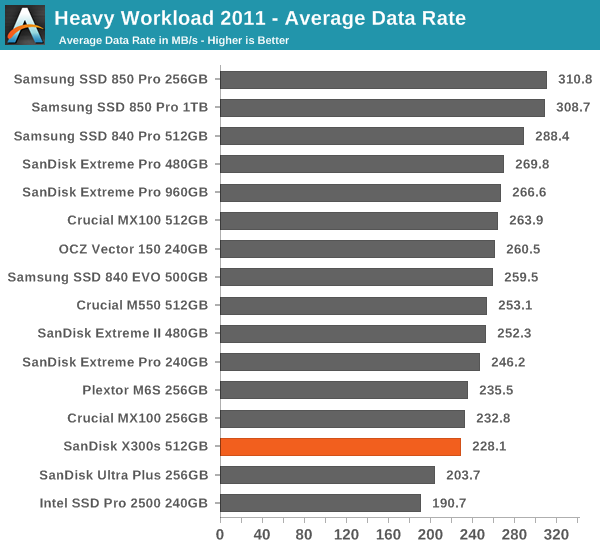SanDisk X300s (512GB) Review
by Kristian Vättö on August 21, 2014 2:15 PM ESTAnandTech Storage Bench 2011
Back in 2011 (which seems like so long ago now!), we introduced our AnandTech Storage Bench, a suite of benchmarks that took traces of real OS/application usage and played them back in a repeatable manner. The MOASB, officially called AnandTech Storage Bench 2011 – Heavy Workload, mainly focuses on peak IO performance and basic garbage collection routines. There is a lot of downloading and application installing that happens during the course of this test. Our thinking was that it's during application installs, file copies, downloading and multitasking with all of this that you can really notice performance differences between drives. The full description of the Heavy test can be found here, while the Light workload details are here.

The X300s does not perform that well in our 2011 Storage Benches. I would say that the 2011 Benches, especially the Light suite, are closer to a typical corporate workload with lots of email and office use, so I would give more value to that instead of the 2013 Bench. The X300s is still okay in both 2011 Benches and better than the Intel SSD Pro 2500, but I was expecting a bit more given the performance of the Extreme Pro and Extreme II.











34 Comments
View All Comments
vaayu64 - Thursday, August 21, 2014 - link
Thanks for the review, as always =).If you have the opportunity to meet with sandisk, can you please ask if there will be a msata version of their extreme or ultra ssd.
vaayu64 - Thursday, August 21, 2014 - link
Another question, does this X300 provide power loss protection?Regards
hojnikb - Thursday, August 21, 2014 - link
Looking at the PCB it appears not.Samus - Thursday, August 21, 2014 - link
That's too bad since it clearly has a piece of (undisclosed capacity) memory on the PCB. Looks to be a 128MB DDR2 chip. I wonder if any user data is stored in there of if it truly caches only the indirection table?Kristian Vättö - Thursday, August 21, 2014 - link
The X300s does not have capacitors to provide power-loss protection as that is generally an enterprise-only feature. SanDisk does have a good white paper about their power-loss protection techniques, though.http://www.sandisk.com/assets/docs/unexpected_powe...
Samus - Friday, August 22, 2014 - link
Enterprise-only feature? Many mainstream drives have capacitors dating back to the Intel SSD 320 (X25-M v3)Some of the cheapest SSD's on the market have capacitors (Crucial MX100) so its inconceivable to leave them out in 2014.
Kristian Vättö - Friday, August 22, 2014 - link
"Many mainstream drives have capacitors dating back to the Intel SSD 320 (X25-M v3)"There is only a handful of client-grade drives that provide power loss protection in the form of capacitors (Crucial M500, M550 & MX100, Intel SSD 730 & SSD 320 are the only ones I can remember).
The SSD 320 was never strictly a client drive as Intel also targeted it towards the entry-level enterprise market, hence the power loss protection. The SSD 730, on the other hand, is derived from the DC S3500/S3700, so it is basically a client tuned enterprise drive.
The power loss protection in the MX100 and other Crucial's client drives is not as perfect as their marketing makes you think. Crucial only guarantees that the capacitors provide enough power to save the NAND mapping table, which means user data is vulnerable to data loss. That is why the M500DC uses different capacitors because the ones in the client drives do not provide enough power to save all writes in progress.
SanDisk's approach is to use nCache (i.e. an SLC portion) to flush the NAND mapping table from the DRAM more often. The lower write latency that SLC has ensures that in case of a power loss, the data loss is minimal but it is true that some data may be lost. Crucial/Micron operates all NAND as MLC, which is why they need the capacitors to make sure that the NAND mapping table is safe.
hojnikb - Friday, August 22, 2014 - link
On the subject of mapping tables; how does controllers like sandforce (and some marvell implementations) work without DRAM ? Do they dedicate a portion of flash for that and how do they keep track of that portions activity (eg block wear) ?Also, since some of the manufactures use pseudo SLC (ie MLC/TLC acting as SLC) how is endurance of those cells affected ? Can SLC portion last longer than normal MLC/TLC ?
Kristian Vättö - Friday, August 22, 2014 - link
The controller designs that don't utilize DRAM use the internal SRAM cache in the controller to cache the NAND mapping table. It just requires a different mapping table design since SRAM caches are much smaller than DRAM. Ultimately the mapping table is still stored in NAND, though.Pseudo-SLC can definitely last longer than MLC/TLC. With only one bit per cell, there is much more voltage headroom as there are only two voltage states.
hojnikb - Friday, August 22, 2014 - link
So really, MLC/TLC and SLC dies do not differ much internally. I'm guessing that real SLC just uses less on die error correction than MLC, but cells shouldn't be that different at all. Same i suppose goes for TLC aswell.If this is the case, it brings an interesting question; If one were to buy MLC drive and wanted SLC grade endurace, it could (if access to firmware was available) tweak the firmware in a manner, so the whole drive would act as a pSLC; obviously at a cost of performance. Something like nCache 2.0, but expanded to whole capacity.
I believe some cheap flash drive controllers offered something like that using their MPtools. I remember messing around with a cheap TLC based flash drive; Once done, i ended up with 1/3 of the capacity, but write speeds increased dramaticly.